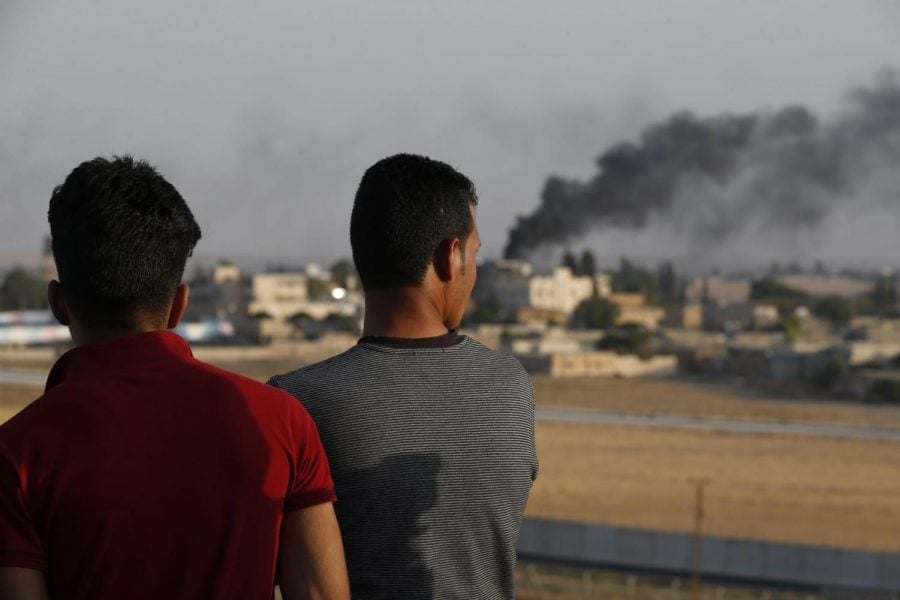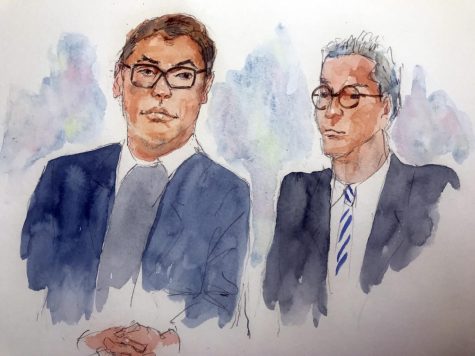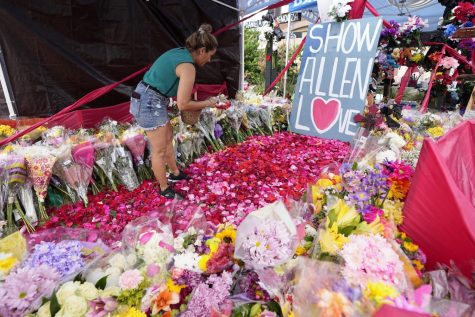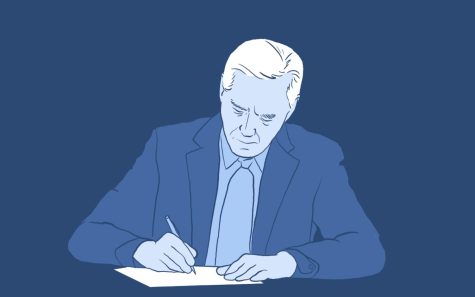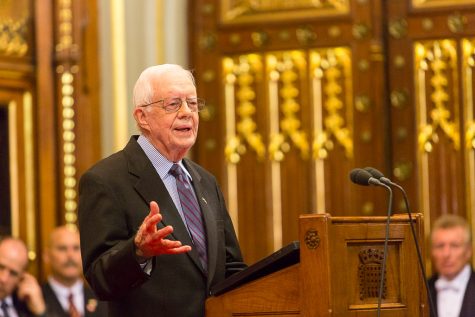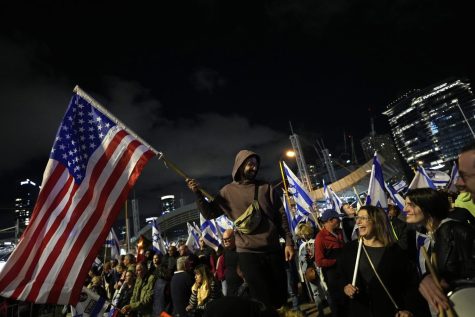Turkish offensive launched in northern Syria
People standing on a rooftop in Akcakale, Sanliurfa province, southeastern Turkey, at the border with Syria, watch as in the background smoke billows from fires caused by Turkish bombardment in Tal Abyad, Syria, Sunday, Oct. 13, 2019.
A Turkish assault on northern Syria entered its fifth day Sunday in the wake of the U.S.’s drawdown of operations in the region.
Turkish President Recep Tayip Erdogan announced Saturday, Oct. 5 that military operations against the predominantly Kurdish Syrian Democratic Forces (SDF) would begin, a day before President Donald Trump announced that U.S. forces, which had been supporting Kurdish-led forces, would withdraw from Syria. There are roughly 1,000 U.S. troops in Syria, mostly in efforts to combat the remnants of the Islamic State (IS) militant group.
“Turkey will soon be moving forward with its long-planned operation into Northern Syria,” White House Press Secretary Stephanie Grisham said in a statement on Sunday, Oct. 6. “The United States Armed Forces will not support or be involved in the operation, and United States forces, having defeated the ISIS territorial ‘Caliphate,’ will no longer be in the immediate area.”
The decision to withdraw American forces from Syria was met with widespread criticism from world leaders and U.S. lawmakers across the political spectrum. Trump ally Lindsay Graham, R-SC, said the move “will be the biggest mistake of his presidency” calling it “a disaster in the making.” Critics largely cited the need to prevent a resurgence of IS, a key reason for U.S. support of Kurdish-led forces, while expressing concern that Turkey may not be able to contain the remnants of the terror group.
Trump similarly announced a withdrawal of U.S. forces in Syria in December, which also received widespread backlash within Washington and resulted in the resignations of then-Defense Secretary Jim Mattis and U.S. envoy Brett McGurk.
According to the U.K.-based Syrian Observatory for Human Rights, 54 civilians have so far been killed in the Turkish ground and air offensive. The International Rescue Committee (IRC) said as many as 300,000 people could be displaced as a result of the military strikes.
As the military offensive, termed “Operation Peace Spring,” began Wednesday, Turkey launched airstrikes and heavy artillery at Kurdish military targets. A ground offensive began later in the day. The IRC estimated that over 64,000 fled their homes in northeast Syria between Wednesday and Thursday.
SDF officials claimed they successfully repelled an attack on Tal Abayad, a town on the Syria-Turkey border Thursday. The town of Akcakale on the Turkish side of the border was hit by mortar fire, killing two and injuring 46 people, according to Turkish officials.
On Friday, Turkish artillery fire struck an area near a U.S. operating base in the city of Kobani. No soldiers were injured, and a Department of Defense statement warned Turkey to “avoid actions that could result in immediate defensive action.”
Over the weekend, thousands of pro-Kurdish protesters took to the streets across Europe to protest the Turkish military offensive. There were also protests in Washington, D.C.
Syrian state-run SANA news agency posted photos of hundreds of people in the northeastern Syrian towns of Qamashli, Hasaka and Deir Ezzor said to be protesting “in rejection of the Turkish aggression and U.S. presence on Syrian territory.”
The bloody Syrian Civil War, which began in 2011, has primarily been fought between anti-government rebels and government forces of Syrian President Bashar al-Assad. But the war, which has resulted in what the United Nations’ Refugee Agency calls “the largest refugee crisis in the world,” has also become a proxy conflict for other actors with strategic interests in the region, including Iran-backed militias and Russian forces that support the Syrian government.
Tens of thousands of militants loyal to IS also traveled to fight in Syria; the group’s efforts to create its own “caliphate” in Iraq and Syria reached its height in 2014, when IS controlled key swathes of both countries. Today, IS has little territory and the Syrian government controls most of the country, though analysts warn IS is still a threat — particularly in prison camps maintained by Kurdish-led forces, where they could escape amid the current fighting.
Among the Kurdish forces maintaining such camps are the People’s Protection Units (YPG), which make up the majority of the U.S.-backed opposition forces. Ankara views them as terrorists with close ties to the outlawed Kurdistan Workers’ Party (PKK), which it has been at war with since 1978. The YPG is an arm of the Democratic Union Party (PYD), which controls a de-facto autonomous Kurdish region called Rojava near the Syrian border with Turkey.
“At the end of the day, Turkish leadership believes that undercutting the YPG/PYD in northern Syria is the main and existential policy goal,” said Sibel Oktay, an assistant professor of political science and global studies at the University of Illinois at Springfield. “Turkey considers this group as the offshoot of PKK in Turkey, so the country’s priority is to eliminate terrorism from that border region.”
The SDF maintains prison camps for captured IS militants and their families, including thousands of women and children at the notorious al-Hol camp in northeastern Syria. Many of the detainees are foreigners, and Kurdish officials have repeatedly asked the international community for assistance in repatriating the prisoners so they can be tried in their country of origin.
“The Syrian Kurdish forces, who were instrumental in the fight against ISIS, are exposed to Turkey in the north,” Oktay said. “Assuming that there are still ISIS sleeper cells in the region, US withdrawal exposes Kurds to those units as well. … I’m concerned that we might see some prison breaks in the next weeks and months, which would be deleterious for the fight against ISIS.”
Talks had been ongoing between Washington and Ankara over a 30 km deep, 120 km wide “safe zone” along the Turkey-Syria border to protect hundreds of thousands of Syrian refugees in advance of a Turkish assault on Kurdish-controlled areas in northern Syria. But Turkish officials complained that the process of creating the safe zone was moving too slowly, and U.S. officials were unsatisfied with the terms.
“I think the intent was always to end up in a conflict with the SDF, it was just a matter of getting the U.S. out of the way,” said Derek Davison, an international affairs analyst and editor of online foreign policy publication LobeLog. “From the U.S. perspective, I think Turkey’s demands were too great in terms of the size of the zone and the number of refugees they want to resettle there, which will inevitably change the demographics of the region even though Turkey denies that it wants to do that. Everybody’s seen what they did in northwestern Syria, displacing Kurdish residents in favor of returning Arab refugees, and that’s presumably what they’re planning now for the northeast.”
Treasury Secretary Steven Mnuchin said on Friday that Trump would sign an executive order authorizing sanctions on Turkey if needed. Mnuchin said the president’s concerns include targeted attacks on civilians, ethnic and religious minorities and the potential for detained IS fighters to go free.
Members of the Trump administration have sought to dispel the notion that by pulling U.S. forces out of northern Syria they are abandoning America’s longtime Kurdish allies; in an interview Wednesday with the PBS Newshour, for example, Secretary of State Mike Pompeo denied giving Turkey “a green light” to launch its offensive. But Trump himself has made comments appearing to justify the move, saying on Twitter Monday, Oct. 7 that “The Kurds fought with us, but were paid massive amounts of money and equipment to do so,” while on Wednesday citing an article he had read in saying, “They [the Kurds] didn’t help us in the Second World War, they didn’t help us with Normandy.”
The Pentagon finally responded Friday, with Defense Secretary Mark Esper telling reporters, “We have not abandoned the Kurds. Let me be clear about that. We have not abandoned them.
“Nobody green-lighted this operation by Turkey — just the opposite. We pushed back very hard at all levels for the Turks not to commence this operation. But Lord knows they have opposed this relationship between the United States and the YPG since its infancy in 2014. The Turks have opposed it all along the way, and so we should not be surprised that they’ve finally acted this way.”
Oktay said Trump’s decision to withdraw troops now may be tied to both the ongoing impeachment inquiry against him led by House Democrats and the 2020 U.S. presidential campaign.
“Academic research tells us that leaders who are hard-pressed at home use this kind of diversionary foreign policy frequently,” she said. “Second and relatedly, he may be after scoring some points at home in the run up to 2020. Bringing troops back home is a strong move that could capture the hearts and minds of voters, after all.”


